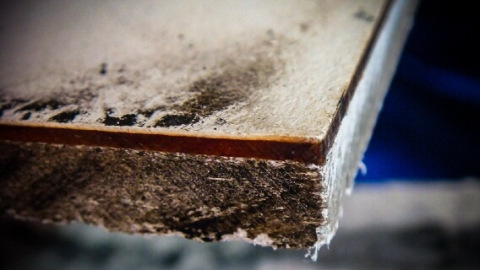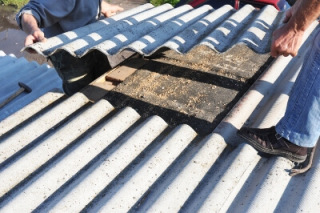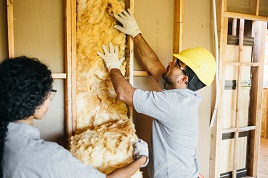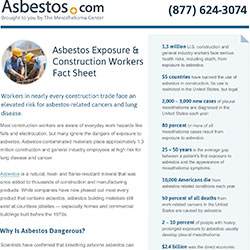
Construction Workers and Asbestos Exposure
Construction workers have a high risk of occupational asbestos exposure and of developing mesothelioma. Asbestos found in contaminated construction materials such as paint, spackling, roof shingles, masonry compounds and drywall can be inhaled, which may lead to mesothelioma in construction workers.

How Are Construction Workers Exposed to Asbestos?
Construction workers are exposed to asbestos when they cut, drill or otherwise alter products that contain asbestos. Disturbing these materials can release asbestos dust, which quickly spreads throughout the air at construction sites. Centers of Disease Control and Prevention estimates place the number of construction and general industry workers experiencing asbestos exposure on the job at 1.3 million people per year.
Asbestos is friable, meaning its fibers crumble easily into dust. This dust is then easily inhaled. When construction workers inhale asbestos dust, it can get trapped in the lungs and cause damage and illnesses such as mesothelioma. It can also travel home on clothes of exposed workers, leading to secondary exposure of family members.
- Cutting or otherwise altering asbestos-containing products
- Demolition of asbestos-containing materials, such as roofing, insulation, wallboard or tiles
- Handling asbestos-containing construction materials for installation, removal or repair
Our research shows most asbestos exposure of construction workers today occurs during renovation and demolition rather than in new construction. This is because the U.S. Environmental Protection Agency banned the last remaining allowed uses of chrysotile asbestos in March 2024. However, the toxic mineral is still present in many older homes and commercial buildings.
Manufacturers produced asbestos construction materials until the 1980s and 1990s. The mineral was a popular choice for its durability and fireproofing properties. Construction workers faced asbestos exposure when installing materials that contained asbestos during this period. Many of these workers continue to develop asbestos-related cancer and lung diseases today.
Types of Construction Jobs With Risks of Asbestos Exposure
Construction jobs where workers come in direct contact with asbestos materials have the highest risk of exposure. This includes masonry workers who handle asbestos-containing concrete, demolition teams, insulation installers, plumbers and roofers. These jobs all work with materials known to contain asbestos.
- Bricklayers
- Bulldozer operators
- Carpenters
- Crane and hoist operators
- Demolition and wrecking crews
- Drywall hangers and tapers
- Home renovators
- Insulation workers
- Laborers
- Masonry workers
- Pipefitters
- Plasterers
- Plumbers
- Roofers
- Tile setters
While these jobs have the highest link between construction workers and asbestos exposure, many other construction professionals are also at risk. Because asbestos dust is very fine, it can easily travel throughout a job site. Air handling systems can also disperse it throughout buildings. Workers without proper respirators may then inhale the dust.

Get help paying for treatment and other expenses by accessing trust funds, grants and other options.
Access Funds NowBricklayers and Masons
Today, bricklayers and masons are at risk of asbestos exposure when cutting or demolishing bricks. Historically, many concrete products contained asbestos, so exposure also used to occur when mixing raw asbestos into blocks, bricks, mortar and other masonry products.
Masonry workers release asbestos-containing dust when they disturb building materials containing asbestos. Removing materials such as asbestos-cement sheets can result in concentrations of asbestos dust higher than allowed thresholds. Power tools, such as saws and drills, magnify this effect.
Drywall Workers
Drywall workers can face asbestos exposure during construction when they cut into or remove drywall and plaster containing the mineral. This releases harmful dust into the air that workers then inhale.
Historically, workers were exposed to asbestos when plastering or patching holes in drywall sheets with asbestos-containing compounds. A 2022 study in the Annals of Work Exposures and Health showed 24% of Canadian drywall workers faced work-related asbestos exposure. Manufacturers added chrysotile asbestos to joint compound drywall products before the Consumer Product Safety Commission banned its use in 1977.
Painters
Painters face exposure to asbestos today when they sand, scrape or otherwise disturb textured coatings containing asbestos. Before restrictions, painters would often spray asbestos-containing spackling compounds on surfaces before painting them to create textures. Some textured coatings and paints, such as popcorn ceilings, also contain asbestos.
Several mesothelioma and lung cancer registries have identified elevated disease rates in former painters, indicating that workplace exposure is common. A recent study ranked painters in the top 5 trades with the highest exposure to hazardous chemicals and toxic additives.
Roofers
Roofers come into contact with asbestos when removing old roofing materials. Asbestos was a common component of some residential and commercial roofing materials because of its fireproofing properties. Additionally, a 2022 study found natural weathering of asbestos cement roofing resulted in potentially harmful exposure.
Tile Setters
Tile setters experience asbestos exposure when damaged tiles release the fibers into the air. In the past, exposure also occurred when they mixed and spread grout containing asbestos.
Although asbestos is no longer used in vinyl and other flooring tiles, it was a common material in the past. A 2021 study reported chrysotile asbestos concentrations of up to 25% in vinyl flooring.

Learn about your diagnosis, top doctors and how to pay for treatment.
Get Your Free GuideAsbestos Products Associated With Construction Workers

Many construction products potentially contain asbestos, including contaminated paint, spackling, roof shingles, masonry compounds and drywall. Research from 2024 indicates as many as 1.3 million U.S. construction industry workers are still at risk of occupational asbestos exposure and mesothelioma cancer.
Over the last century, manufacturers produced thousands of commercial construction materials made with asbestos. Manufacturers typically added asbestos to these products to make them stronger and fire-resistant. The EPA suggests that the vast majority of the nation’s 733,000 public and commercial buildings contain asbestos.
- Construction Felts: Calcot, Syncot and Thermesh manufactured asbestos-containing construction felt products.
- Drywall: Asbestos drywall products included gypsum board, plasters, millboard and drywall joint compounds. One study found asbestos in all of the taping products and one-third of the patching products the researchers tested.
- Duct Tape: Some duct tape products contain up to 45% asbestos.
- Flooring: Brands such as American Biltrite, Congoleum and Kentile used asbestos fibers in their flooring tiles. Construction workers often cemented these tiles in place with asbestos mastics and grouts, such as G.W. Berkheimer’s plastic roof cement.
- Insulating Cement: Careytemp, HiLite, Gum-Bestos and Detrick were producers of asbestos cement products.
- Insulation: Workers sprayed products such as Cafco D and Therm-O-Flake (which contained up to 35% chrysotile asbestos) on steel columns, aluminum sheets and other metal structures needing to withstand high temperatures.
- Joint Packing: Historically, joint packing would contain up to 40% asbestos and is still present in many older homes and buildings.
- Roofing: Eternit, Johns Manville, National Gypsum and GAF are companies that made asbestos shingles, and many roofers used CertainTeed asbestos roof coating.
- Siding Panels: Transite, Flintkote and National Gypsum produced siding panels containing asbestos fibers.
- Textured Paints and Ceiling Texturizing Products: These products typically contained less than 5% asbestos but are easily friable when removed.
- Vermiculite Products: Manufacturers continued to produce vermiculite products contaminated by asbestos until the early 1990s.
On March 18, 2024, the EPA announced a final rule banning the last remaining uses of asbestos. It may take years for the final phase-out to occur.
Current U.S. laws continue to allow construction companies to use certain asbestos products that meet government guidelines, such as roofing felt and coatings, millboard, pipeline wrap, vinyl floor tiles, cement sheets, shingles, pipes and nonroofing coatings. Older and historic construction work, renovations and overseas projects remain especially dangerous.
Manufacturers That Made Products Construction Workers Use
Some of the most popular manufacturers using asbestos in products were W.R. Grace, Johns Manville, Owens Corning and Celotex. Many of these companies later had to deal with the legal liabilities of exposing workers to asbestos.
- Artra Group: Now known as Synkloid, the company used asbestos in its product line between 1949 and 1976.
- Brunswick Fabrications: Asbestos-containing products made by fabrication companies such as Brunswick are present in homes, businesses and millions of buildings across the U.S.
- California Portland Cement: Roland McKinney was a plasterer who died at age 64 of asbestos lung cancer. His family claimed his occupational exposure was due to products manufactured by California Portland Cement.
- C.E. Thurston & Sons: Thurston installed, repaired, removed and distributed asbestos insulation made by other companies until the late 1970s.
- Celotex: From the 1920s to the 1980s, Celotex manufactured asbestos insulation and construction materials.
- Delaware Insulation: This company manufactured asbestos-containing insulation products.
- Flintkote Company: The Flintkote Company made asbestos roofing materials from the 1930s until the 1980s.
- Fuller-Austin Insulation: The Fuller-Austin Insulation Company sold, distributed and installed asbestos-containing insulating materials.
- Hanson Permanente: This company manufactured asbestos-containing cement.
- Johns Manville: Founded in 1858, Johns Manville was one of the first companies to manufacture products with asbestos, including fire-resistant roofing.
- Kentile Floors: Kentile produced large, durable vinyl floor tiles made with up to 25% asbestos.
- Owens Corning: Until 1972, Owens Corning added asbestos to its ceiling tiles, cement and insulation for pipes, ducts, equipment and cold storage systems.
- U.S. Mineral Products: U.S. Mineral Products materials made with asbestos included insulating cement, patching fiber and other fireproofing products.
- W.R. Grace: W.R. Grace & Co. manufactured asbestos-containing plaster, cement and insulation, including Zonolite loose-fill attic insulation installed in tens of millions of homes throughout the U.S.
Experienced construction workers can sometimes identify asbestos hazards by appearance, labeling, the installer or the manufacturer. If you’re not trained in identifying dangerous products or can’t determine if a product contains asbestos based on the information you have, treat the material as if it contains asbestos.
Construction Workers and Mesothelioma
Most occupational health organizations agree asbestos in construction materials can lead to increased rates of mesothelioma and other diseases. A 2023 study in BMJ Open Respiratory Research established a connection between construction workers and elevated risk of respiratory illnesses. This research identified asbestos fibers and harmful dust as contributing factors.
A 2020 analysis noted 5 years of work in the construction industry or at a U.S. Department of Energy site resulted in a risk of death from cancer comparable to that of an individual with a personal or family cancer history or COPD diagnosis. An additional 2024 study of past DOE workers showed construction workers at DOE sites had a significant risk of occupational illness, specifically elevated risks of cancer.
The problem is widespread and affects a large number of construction workers. According to a European Commission report from 2022, more than 70,000 workers died in 2019 from past exposure to asbestos.
Terry was a gifted athlete whose strength and determination brought him to the U.S. in 1970. He worked construction for almost 10 years, where he likely was exposed to asbestos. “I was unlucky to have gotten this disease, but have absolutely no regrets. I worked and worked and worked, made and lost a couple of fortunes. Life has been a pleasure here.”
Legal Options for Construction Workers Exposed to Asbestos
Legal options for construction workers exposed to asbestos include filing workers’ compensation insurance claims or lawsuits. These actions can help cover the cost of medical care for asbestos-related illnesses.
Workers’ compensation provides relief from paying for medical costs. However, asbestos attorneys we’ve interviewed say the long latency period of mesothelioma may make this route difficult or impossible.
We traditionally sue the manufacturers of the asbestos-containing products. Those are the companies that sold it and supplied it.
When a construction worker is diagnosed with mesothelioma or another disease after being exposed to asbestos on job sites in the past, they may be able to hold companies responsible for using asbestos-containing building materials. Many companies used these materials knowing of the risks and without providing proper protective equipment. Compensation may include the cost of past and future medical expenses.
Many companies that produced asbestos building materials have filed for bankruptcy or closed. Bankruptcy proceedings established trust funds to provide proper care for individuals exposed to asbestos.
Notable Cases and Verdicts
Construction professionals who developed mesothelioma have received notable jury awards. In 2020, a Washington jury awarded Raymond Budd and his wife nearly $13.5 million in damages for a mesothelioma diagnosis as a result of his asbestos exposure as a drywall worker. Kaiser Gypsum later appealed the verdict and lost.
- Insulator Installer
-
A 2013 case involved an insulator worker and his wife. A California jury decided Owens-Illinois asbestos pipes were defective and hazardous. It awarded the couple $27.3 million and levied an additional $11 million against Owens-Illinois.

- Union Painter
-
One notable lawsuit involved a unionized painter who developed mesothelioma in his 60s. The painter spent most of his career painting with texturized topcoats and fillers from asbestos manufacturers such as Union Carbide, Kelly Moore and Bondex. Instead of settling out of court, he pursued a traditional trial. The jury awarded him an $11 million verdict.

- Construction Supervisor
-
A former Florida construction supervisor and superintendent developed peritoneal mesothelioma. He recalled handling asbestos compounds and ceiling textures from manufacturers including Kaiser Gypsum, Union Carbide and Premix-Marbletite. A jury awarded him $14 million.

- World Trade Center Contractor
-
In 2012, the Supreme Court of New York County upheld a ruling in favor of a contractor who spent 15 years cutting and installing asbestos tiles and sheetrock in the original World Trade Center. Other workers further contaminated the site with asbestos fireproofing, tape and pipe coverings.

- Ceiling Tile Installer
-
A Missouri court of appeals reviewed a case a widow whose husband died of mesothelioma filed in 2012. He developed the malignant cancer after working with Bondex drywall products and Simpson Timber ceiling tiles. A settlement with one manufacturer resulted in the jury reducing the initial $4.5 million verdict.

Many construction professionals have received compensation for asbestos-related injuries. The average mesothelioma settlement is between $1 and $2 million. Jury trial awards tend to be higher.
If you or a loved one developed mesothelioma after asbestos exposure in a construction trade, you may be able to file for compensation. Speak to an experienced mesothelioma attorney to discuss your options.

View Our Asbestos Exposure & Construction Workers Fact Sheet
Help raise asbestos awareness by printing and sharing this handout, which covers the key facts about asbestos hazards in the construction industry. With more awareness, we can prevent harmful exposures and make worksites safer for everyone.
Common Questions about Construction Workers and Asbestos Exposure
- How often are construction workers exposed to asbestos?
-
Construction workers face frequent asbestos exposure from legacy products. They’re most likely to come into contact with harmful asbestos fibers when remodeling or demolishing buildings built before 1977. Workers may experience prolonged exposure over years of construction work in these environments.
- What are the health risks of asbestos exposure for construction workers?
-
Asbestos exposure contributes to several serious health conditions, including mesothelioma and laryngeal, lung and ovarian cancers. It’s also associated with several non-cancerous lung conditions, such as asbestosis, collapsed lung, COPD, fluid buildup and pleurisy.
Most health conditions occur after prolonged exposure to asbestos, such as working with or around it daily. However, there is no safe threshold for exposure. - How can construction workers protect themselves from asbestos exposure?
-
Construction workers should wear proper personal protective equipment and follow established procedures for safe handling when working with asbestos. Respirators filter dust particles and can help keep asbestos fibers out of the lungs. Protective clothing can reduce secondary exposure. Using a HEPA-filter vacuum and establishing containment areas are additional workplace best practices.
- What should construction workers do if they suspect asbestos is present at a worksite?
-
Construction workers should report any suspected asbestos to a supervisor so they can take proper precautions. According to OSHA standard 29 CFR 1926.1101, which includes determining asbestos levels, identifying regulated areas and finding ways to control and reduce airborne asbestos levels.
- Can construction workers receive compensation for asbestos-related illnesses?
-
Construction workers who develop asbestos-related illnesses may be able to seek compensation through legal action. Many companies established asbestos trust funds to pay for medical care and losses associated with asbestos exposure.
Because these cases are work-related injuries, workers’ compensation may also be an option. An experienced lawyer can help assess your case and compensation options.




